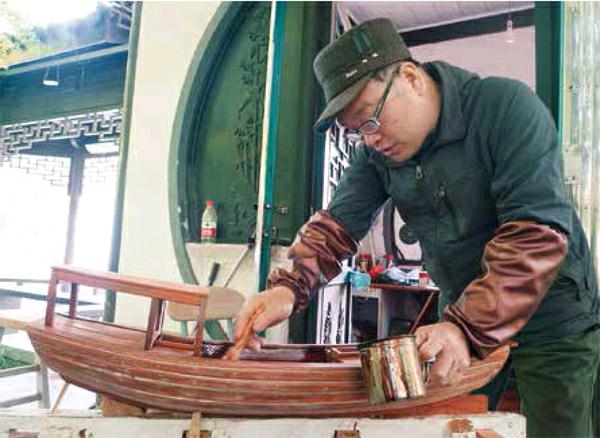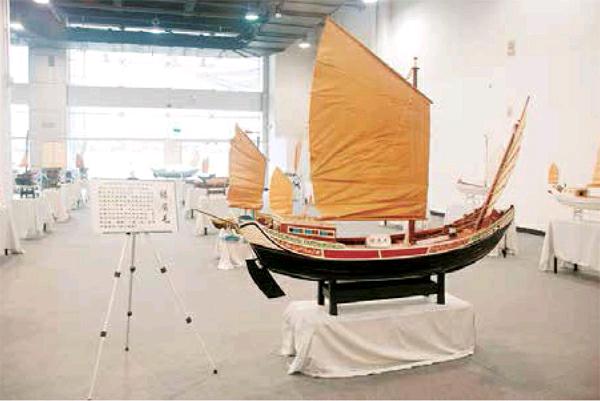杭州工匠潜心精制古船模
2017-11-06俞琪
俞琪
喜欢做船模的人不少,但是把船模按比例放大后,能制成可以实际行驶并经久耐用的船只,不仅是杭州,在全省都屈指可数。71岁的庄恭礼就是其中之一,他的“江干古木船制作技艺”已被列入杭州市非物质文化遗产项目。
最近,庄恭礼在制作一艘南湖红船的模型,看起来已经到了给船身刷漆的阶段,但庄恭礼笑说,这不过才进行到四分之一。
“做船这件事,说起来简单,但要给你说透,复杂得很。”庄恭礼说。
刻苦学习祖传技艺
庄恭礼其实不是杭州人,他的家乡在温州洞头。因为从小在海边长大,与船的缘分自是不浅。“祖上开始就有人制作木船,我的手艺传自我外公。”庄恭礼说。

杭州工匠庄恭礼。
家里5个孩子,庄恭礼虽然排行第二,但老大是姐姐,再加上父亲体力较差,所以养家糊口的重担很早便落到了他身上。念了6年书后,16岁时,庄恭礼便跟着外公开始学习制造木船。
“刚开始学,外公就教我一句口诀‘四六配。”庄恭礼说,“四六配”简单地说就是船体各处的比例,但具体到画图设计,一时半会还真说不清楚。而且“四六配”只是基础,根据船的不同,会有不同的“配”。比如“四六配”相对来说在小一些的船只上用得多,大一点的船就需要“三五配”。
庄恭礼说,造船这件事,没点悟性真学不会。他记得那时在家乡的造船厂做临时工,大部分工人都是做维修或是局部制作,能造出整船来的很少。“一般100个学徒来学,最后能学成的大概也就在10个人以内。”
所以,庄恭礼说自己很幸运,有人教,也学得会。当时,造船厂的工作是很吃香的,而且基本上一年365天都开工。“最开始,一天的工资是一元钱,那时候一元钱能买10斤大米,能让我们全家人都吃饱了。”
当然,庄恭礼靠的不仅是悟性,还有刻苦。当时,船厂的老师傅会给大家布置任务,庄恭礼总是挑难度大的,遇到不会的,就去请教老师傅。久而久之,他的技术越来越精湛。
廿年钻研精制船模
上世纪80年代,因生计所需,庄恭礼到了上海,开办家具厂。因为工作忙,造船的手艺也就搁下了。
直到1997年,因為子女到杭州工作,庄恭礼也就跟着孩子们到杭州定居了。“闲下来了,就想起这门手艺,觉得还是不能丢。”庄恭礼说。
最初,庄恭礼在杭州笕丁路上的五金城里有一间工作室。每天就在工作室里,钻研他的船模,怎么做得更漂亮。“一般我们的经验,看起来漂亮的船用起来也好,看起来就不舒服的船,下水肯定是开不好的。”
这20来年里,庄恭礼前前后后制作了40余艘木制船模。
“有人要买,我都舍不得,只有儿子来要,我给了他2艘。”庄恭礼说,其中有一艘就是南湖红船模型,所以这次他再做一艘,也是因为船模里少了这个类型。
笔者问庄恭礼,是不是计划把各类船的模型都做齐?他哈哈大笑,说:“我们国家船的类型有几千种,做全是不可能的,但我想我自己感兴趣的船型,能尽量多做一些。”
庄恭礼细细琢磨,根据各个水域的情况不同,即便是同一类船,形状也会有所区别。比如东海的船通常是两头尖,船身比较长,而南海、渤海的船,船身较短较宽,整体也较高。
“从全世界来看,我们国家造船的技艺也是比较高的。举个例子,国外很多海上航行的大帆船,出一次海需要六七十名水手,如果是我们国家同等吨位的船只,大概一半船员就可以操作了。”庄恭礼说。
非遗展示期盼传承
目前,在杭州闸弄口街道的支持下,庄恭礼在运河边的会安阁有了一间船模工作室,他的作品也在会安阁及江干区文化中心非物质文化遗产展示馆等处保存和展示。
“国内掌握这门技艺的人确实不多了,之前苏州博物馆想定制一艘木制船模,说是找了很多地方找不到师傅,最后找到了我。”庄恭礼说,当时这艘船模制作了大约2个月时间,费用是2.5万元,“我用的是香樟木,如果用红木的话,价格要翻一番。这样的船模放上几百年是没有问题的。”

庄恭礼制作的古木船微缩船模。
至于技艺的传承,庄恭礼说,其实感兴趣的人很多,包括附近有很多小朋友都喜欢到他的工作室来,也有不少退休了闲不下来的人,想跟他学习。
“粗浅地教一教还可以,但是真的要收学徒,我这里的场地还是不够大。”庄恭礼说,虽然目前对于非遗的传承与保护,政府已经采取了不少举措,包括场地建设和资金投入,但他还是期盼着能有更多来自各方的支持和关注,让这门技艺传承下去。
“我现在做的船模都是严格按照实际可以使用的船只,等比例缩小来做的,如果将来技艺难以传承,至少还有个模板。”庄恭礼说。
Craftsman Makes Ancient Ship Models
By Yu Qi
Zhuang Gonglis craft makes a difference. The 71-year-old craftsman now living in Hangzhou makes ship models that can actually sail. His craft of making ancient ship models has been inscribed on the list of intangible cultural heritage of Hangzhou.endprint
Zhuang is not a native of Hangzhou. Born in Dongtou, Wenzhou in southeastern Zhejiang, he was exposed to shipbuilding in his childhood years. “Shipbuilding ran in our family in ancient times. I learned all the skills from my maternal grandfather,” recalls Zhuang.
After spending six years at school, the 16-year-old started his shipbuilding apprentice at the tutelage of his maternal grandfather. He recalls that it takes much engineering knowledge to build a ship. Most workers at the local shipyard could do a job or two, but few could make a complete ship. In his apprentice years, of 100 apprentices who studied shipbuilding, only about ten graduated as masters who could do all the jobs in building a complete ship. “I was lucky. I had masters who taught me and I was able to learn. Back then, shipbuilding paid handsomely and we had work to do all the year round. At first I was paid one silver dollar a day, which could buy five kilos of rice. I put the food on the kitchen table for my family,” recalled Zhuang.
Zhuang, as an apprentice, had more than smartness. He worked diligently. Back then, he always picked the hardest assignment when masters at the shipyard appointed apprentices to do different jobs. If he ran into some difficulties, he was able to ask masters for advice and suggestion. This way, he became a good shipbuilder.
In the 1980s, he went to Shanghai and set up a furniture factory. In 1997 he moved to Hangzhou after his adult children set up their homes in the city. Without much to do, he picked up shipbuilding as a hobby and began to build ship models. He had a workshop at a hardware market in a suburb of the city. He focused on how to make a model looks beautiful. “My experience tells me that a beautiful model sails beautifully and those that look not so nice usually cant survive much in water,” he explains his passion.
Over the past 20 years, he has made 40 some wooden ship models. He cant allow himself to sell his pet projects. He has given away two models at his sons request.
Asked whether he plans to cover a full range of ships in his amateur pursuit, he laughed and said, “It isnt possible to make all types of models, but I will try to build as many as possible.”
With the support of a local community in Hangzhou, Zhuang Gongli now operates a ship model studio at a location on the Grand Canal of China which crisscrosses the city. His works are displayed at the location and at a cultural heritage museum at Jianggan Districts Cultural Center.endprint
“Nowadays there are not so many people who can make a ship model. Suzhou Museum came to me for a wooden ship model after numerous failures to locate a master across the country,” says Gong. It took him about two months to build the ship model at the expense of 25,000 yuan. “I used camphor wood. If kept carefully, the model can last a few hundred years.”
Many people are interested in the shipbuilding technology. Children love to visit his studio and some adults want to study under his tutelage. “I can teach the essentials here. But working together with young apprentices requires a much larger space.”
The government has allotted funds and space for preserving the shipbuilding skills. Zhuang, however, hopes to get much more support from all walks of life. “My models are appropriately miniaturized ships that can actually sail. If my skills and expertise cant be mastered by someone, at least the models are there to be prototypes,” the ship model builder says hopefully.endprint
